Responsible TM Ownership
Helpful Hints and Staying Sane!!
After much discussion we finally made a major decision
to welcome into our family a new member in the form of
an adorable TM puppy. After our initial joy had subsided
we got straight into encouraging the puppy to learn and
experience things, we knew too that we had a great deal
to learn regarding rearing a young puppy into a happy and
well adjusted adult dog.
The breeder we chose was very generous with her time and
loved hearing about our fur baby. Being a responsible owner
means doing everything possible to keep your dog in good
health both physically and mentally.
Health
Puppy vaccinations start at the age of 6 weeks up ‘til
eighteen weeks. A booster is given at 12 months of age
and then every year throughout the life of the dog to prevent
canine parvo, distemper and hepititus. In addition to this
you have all the usual treatments (worming etc) and ear
and eye checks.
Diet
Very slowly maturing – means you have to be extremely
careful to get the mineral / vitamin balance and the amount
and type of food right. 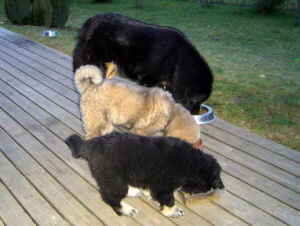 Too
much protein can lead to dogs growing too large too soon
and putting their structure out. Sometimes this cannot
be rectified. For example, pasterns can become weak under
strain. If a dog is too heavy at an early age this puts
stress on tendons and ligaments. If this is not rectified
within a few months this can lead to a foot turning out
slightly sideways for the rest of the dog’s life.
Usually regular checking, early detection and a change
in diet is enough to achieve the necessary balance but
it is always better to prevent such things from happening
if possible.
Too
much protein can lead to dogs growing too large too soon
and putting their structure out. Sometimes this cannot
be rectified. For example, pasterns can become weak under
strain. If a dog is too heavy at an early age this puts
stress on tendons and ligaments. If this is not rectified
within a few months this can lead to a foot turning out
slightly sideways for the rest of the dog’s life.
Usually regular checking, early detection and a change
in diet is enough to achieve the necessary balance but
it is always better to prevent such things from happening
if possible.
The breeder will advise you on the puppy’s diet,
usually small meals at frequent intervals are given up
until the age of 6 months, then it is up to the individual
whether once or twice daily. Avoid foods containing soy,
preservatives and by-products. A premium puppy food for
large dogs is not recommended – it’s essential.
You may also add carrots, natural yogurt and turkey and
chicken necks for variety. NEVER feed your dog cooked bones
such as the remain of a roast lamb dinner.
Clean water should be available at all
times except immediately after robust exercise. My dogs
love a few ice cubes in their water, especially on a very
hot day. 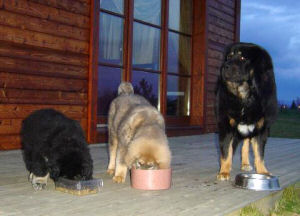 Ensure
the water bowls are in the shade and not direct sunlight
and find a place where this is the case for the entire
day otherwise move the bowl! Steel and aluminum bowls are
preferable over plastic.
Ensure
the water bowls are in the shade and not direct sunlight
and find a place where this is the case for the entire
day otherwise move the bowl! Steel and aluminum bowls are
preferable over plastic.
Try not to feed your dog when you eat.
They will establish a pattern whereby you eat and then
they do. This can lead to demanding dogs and ones that
drool in front of your while you attempt to enjoy your
meal or snack!! It is much better to feed your dogs after
you have eaten (as this would be the case in the pack).
If however you are like Troy and I and prefer to eat
an hour or so after the time we like the dogs to be fed
do what Jan Fennell, the Dog Listener suggests: Take a
couple of dry biscuits (or whatever) out. Prepare the dogs
meals then eat your biscuits in front of them while they
await their meals. They won’t know that this is not
the same as what they are just about to enjoy. All they
will think is that you (the pack leader) is eating first
(as it should be) and they (as members of the pack) are
eating what you leave for them.
Socialisation
Socialisation means your puppy should become acquainted
with all manner of things at a very early age. Meeting
people and other animals will provide him with social skills
that will make him a confident and happy dog.
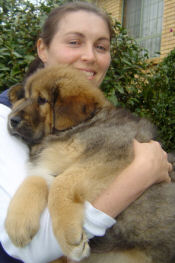

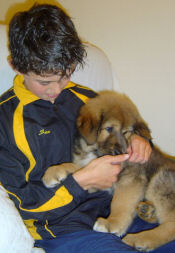
Training
Training should cover everything from cutting nails and
giving puppy a nice first grooming experience, to how to
behave in and outside the home to sit, drop or, if you
are wanting to show - to stack. From an early age puppies
can be taught basic training such as sit, stay, come, etc
as well as learning to tolerate a lead, grooming and a
bath. Later the dog will benefit by attending an obedience
class, enabling him to learn to obey more extensive commands.
The owner must always accompany his or her charge to these
classes, thus establishing himself as the alpha who needs
to be respected. Always be consistent with your dog, it
is the least they deserve.



Crating
As puppies can do a lot of damage in a short time, a crate
in which to contain your dog is useful for the times you
may have to leave him or her unsupervised. Dogs like to
have a special place of their own so make the crate a comfortable
place to be. Situate it with the door tied back in a spot
where he can see what is going on around him. If the puppy
is hesitant to enter the crate, reward him with a treat
or special toy when he has entered the crate. After a few
days he will become familiar with his new place, the crate
will not be seen as a threat and he will go in and out
of it freely. The next step is closing the door when he
enters. As this will not appeal to him at all and he will
make his feelings known by whining and barking. Do not
release him until he has quietened, and hopefully calmed
down somewhat, for if you do he will see a pattern and
continue to misbehave in future. However the puppy will
soon accept being confined if you praise him for his good
behaviour. A crate is also invaluable when you travel and
is a must if you plan to show your dog. It is also a godsend
when you need to leave your dog at the veterinarian so
it’s important to show the dog that a crate is a
safe place and to feel comfortable within it.

Grooming
Once a year, usually in spring and summer, your TM will
shed his undercoat and require daily grooming, a tool called
a rake is ideal for this purpose. At other times brushing
is all which is required to keep their coats in good condition
as TMs are naturally clean dogs. Make grooming an enjoyable
time for both you and your dog. I just love it and my dogs
line up for a brush and a check over! While doing so check
the coat for fleas, hotspots, lumps and eye infections.
Have a vet or breeder show you the correct method of clipping
the dog’s nails.
Nocturnal Barking
Given that TMs have been guarding villagers and property
for thousands of years it is a given they will bring this
to your house. It is simply part of the breed – they
are a guardian breed. Having said that some of our TMs
sleep outside at night and some inside. Quite simply not
all TMs are barkers and some are as quiet as a mouse at
night. Try thanking them for protecting you but then showing
that everything is fine and that it’s okay to relax
now. I remember when we moved houses and lived backing
onto a river. My two dogs barked every time a fish jumped
up out of the water (something that never seemed to happen
while we were fishing!!). I would sit out there
with the dogs, an arm around them and when a fish jumped
up and the dogs would start to go on the offensive, I
would pat them and say: “Fish! It’s okay, fish”.
Use a soothing voice that shows no concern whatsoever.
2 nights later the fish were going crazy but there was
no barking to be heard!
Teach your dogs what are possible threats and what doesn’t
need their attention. Also endeavour to teach your dog
to bark on command and to cease barking for the word: “Quiet”.
The “Uglies”
Although we did not experience this with out first TM
other TM breeders did not believe us when we said that
he grew evenly! You see your TM might look adorable one
day, gangly the next, and later as though he has a pin-sized
head compared to the size of his body OR a puppy with a
head twice the size it should be!! Most of this is normal
and you are lucky if you have a dog who matures evenly,
especially if you are showing him or her! All I can say
is not to worry and just cuddle him when he’s looking
less than the dog you’d hoped for… he is still
the same inside. TMs are the cutest puppies, they may go
through some awkward growing stages but are stunning from
at around 2 years for females and 3 years for males and
improve even more by true maturation (around 3+ years for
females and 5 years for males).
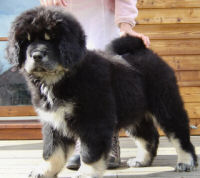 |
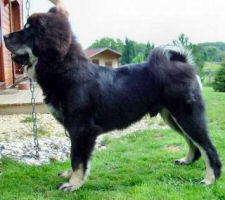 |
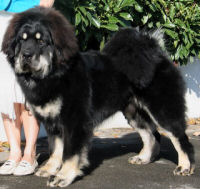 |
Panda at 10 weeks |
Panda at 6 months.... oh dear! |
Panda at 10 months |
TMs – Idiosyncrasies!
The TM is unlike other breeds! Bringing up your TM can
be time consuming, at times frustrating, but always worth
it.
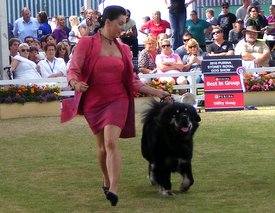 Their
intelligence is what actually makes any ‘training’ more
difficult! I remember that we were the top of the class
in our obedience group but after a few weeks, when the
other breeds had finally come to realize what was being
asked of them and started to rejoice in knowing and doing
what their beloved parents wanted from them, our TM was
bored, had already learnt that and didn’t see why
he had to do it three times in a row!!
Their
intelligence is what actually makes any ‘training’ more
difficult! I remember that we were the top of the class
in our obedience group but after a few weeks, when the
other breeds had finally come to realize what was being
asked of them and started to rejoice in knowing and doing
what their beloved parents wanted from them, our TM was
bored, had already learnt that and didn’t see why
he had to do it three times in a row!!
You see they know EXACTLY what you want from them, but
they don’t necessarily agree that it’s needed.
Many other breeds do things by rote learning and not ever
questioning. Get prepared to ‘debate’ with
your new TM puppy!!!
Believe me, this may sound like extra work (and it is)
but it results in an admiration for your new friend and
a difficulty in going back to the ease of more simplistic
breeds.
My family and I knew how essential it was to spend as much
time with our first TM puppy when it just arrived. Even
though my partner was working from home, I took a week off
work and ensured that the next few weeks I could be flexible
with my hours.
For the first two months we bonded, watched each other
and learnt a great deal. We also attempted to expose our
puppy to as many new experiences, sounds, people and places
as possible. This of course depends on when vaccinations
deem the puppy able to cope with such pursuits.
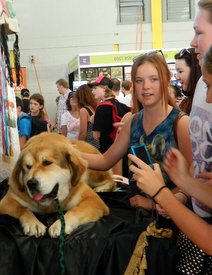 It
is essential that the puppy feel comfortable when placed
in such situations. Your attitude and reaction to these
situations will either help or hinder such learning. It
is so important to expose your puppy to anything and everything
at this time. Puppies will give most things a go and if
exposed to new things calmly and lovingly by you will be
comfortable with them. If an adult dog hasn’t had
these experiences with these things when a puppy it can
become very fearful and jittery. This is the saddest thing
to see.
It
is essential that the puppy feel comfortable when placed
in such situations. Your attitude and reaction to these
situations will either help or hinder such learning. It
is so important to expose your puppy to anything and everything
at this time. Puppies will give most things a go and if
exposed to new things calmly and lovingly by you will be
comfortable with them. If an adult dog hasn’t had
these experiences with these things when a puppy it can
become very fearful and jittery. This is the saddest thing
to see.
We thought we had covered everything. We had read the
books, gone to socialization and obedience training, mimicked
situations in the home and yard and taken our pup to fairs,
fetes, open days, into town, you name it, we did it. Then
when he was12 months of age, just before he went into the
ring for his first real show a lady in a motorized scooter
went slowly past and scared the life out of him!!! This
lady seemed to be a permanent fixture at most shows so
our dog got used to it but it took a little while. When
he was nearly 14 months we were walking through a park
in town and he stopped, dead in his tracks, near a statue.
It was very much a real life form of a man. Our dog could
not understand how a dark ‘man’ didn’t
move and didn’t have a scent. I went over to the
statue and sat next to it, patting it and reassuring my
dog. It took 3 trips for him to go over to it, sniff and
lick it before raising his hind leg to show what he thought
of it!!
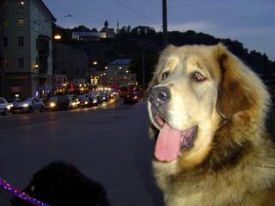 At
15 months he reared back from a $2 electric rocking horse
outside a convenience store! Now this was a dog who walked
down sideshow alley at shows, into town for the Crazy Day
Sales, and into classrooms with 29 pairs of hands patting
him, totally surrounded and not able to ‘check in’ with
me to see that all was well. It is commonly remarked how
calm and totally adjusted he is and yet we still had 3
things which at first glance frightened him.
At
15 months he reared back from a $2 electric rocking horse
outside a convenience store! Now this was a dog who walked
down sideshow alley at shows, into town for the Crazy Day
Sales, and into classrooms with 29 pairs of hands patting
him, totally surrounded and not able to ‘check in’ with
me to see that all was well. It is commonly remarked how
calm and totally adjusted he is and yet we still had 3
things which at first glance frightened him.
Just reassure the dog but don’t ‘mother him
or her –this is very important, if you say “Oh
it’s okay, yes it is a big scary thing isn’t
it, you can be portraying to puppy that they indeed were
right to be and remain scared.
Encourage him or her to explore and show what you mean
by role modeling. Show that just because something is new
and strange that nothing is to fear. You’ll be amazed
how brave they are willing to be when mum is as well!




























